|
|
教学内容基本信息
| 学科
| 英语
| 实施年级
| 高一
| 设计者
| 向华蓉
| 使用教材
| 人教版(2019)高中英语教材必修一
| 单元名称
| Unit4 Natural disasters
| 单元课时
| 8课时
| 单元教学规划
| - 本单元选取了单元整体教学理论作为指导思想和设计依据
- 单元整体教学设计是指教师基于课程标准,围绕特定主题,对教材等教学资源进行深入解读、分析、整合和重组后,结合学习主体的需求,搭建起一个由单元大主题统领,各语篇次主题互相关联,逻辑清晰的完整教学单元,使教学能够围绕一个完整的主题设定单元目标,引导学生基于对各单独语篇小观念的学习和提高,逐步建构基于该观念主题的大观念。(王蔷等,2021)
- 《普通高中英语课程标准》中指出,单元教学要以发展学生英语学科核心素养为宗旨,围绕主题语境整体设计学习活动。教师要认证分析单元教学内容,梳理并概况与主题相关的语言知识、文化知识、语言技能和学习策略,并根据学生的实际水平和学习需求,载教学活动中拓展主题意义。
基于主题意义,使学生在知识建构中逐步形成对单元话题的深层认知,提升英语学科核心素养。
具体而言,有如下五个步骤:
- 基于单元主题意义重新梳理各语篇,提炼为单元主题意义服务的小单元;
- 在单元主题意义的指导下,聚焦小单元进行各语篇的教学设计。
| 整体解读单元多模态语篇,明确主题意义探究的主线
- 本单元为人民教育出版社《普通高中教科书·英语必修第一册(2019 年版)》第四单元Natural disasters。本单元主题语境为“人与自然”,子主题为“人与自然灾害防范”。
【What】
本单元以自然灾害为话题,探讨在“人与自然”的主题之下,当人类面临自然灾害的威胁 时,应该树立防灾意识,不断研究和认识自然灾害,提高在灾害中逃生和生存的能力。
本单元还力图体现“灾害无情, 人有情”的主题意义,即人类在重大自然灾害面前不屈不挠,相互援助,坚定信心,重建家园。 主题图呈现的是一群解放军战士在汶川地震的废墟中运送伤者的感人画面,体现了在发生重大自 然灾害时,军民同心,合力救助受灾人员的大无畏的人道主义精神,突出了解放军战士在赈灾工作中的重要作用和无私奉献。
【Why】
在日常生活中了解自然灾害、积极应对自然灾害、知道防范和减少自然灾害损失的基本措施,这些也是21 世纪公民应该具备的基本素质。“用生命呼吁:增强减灾意识,减少人员伤亡。”是本单元的活动主题,目的是呼吁全球各地 的人们重视自然灾害,树立防灾意识。
深入学习自然灾害相关表达,提升语言能力;梳理整合语篇要素与特征,提升学习能力;传播防灾知识,培养文化意识;批判性地表达自己观点,多途径收集资料,培养思维品质。
【How】
本单元从认识自然灾害的种类开始,到介绍近现代历史上国内外发生过的重大自然灾害事件,再到探讨面对灾害的威胁和所造成的损失时,人们可以采取的应对措施。
本单元的阅读文本通过详细地对唐山大地震发生前各种奇怪现象的介绍,说明地震发生前的很多预兆没有引起当时人们的注意和警觉,帮助学生了解一些地震前兆的知识。文章对地震发生中和发生后的介绍,不仅帮助学生更加生动具体的了解了这段惨痛的历史,也让学生在阅读最后两段关于救援工作和地震重建工作介绍的同时为唐山人民的团结与智慧,拼搏与奋斗精神所震撼和鼓舞。
本单元通过主题阅读Reading1(p50) 纪实性报告文学,描述地震和对Reading2(p54)新闻报道--海啸文本的详细分析和学习,来体现核心素养价值,让学生重视自然灾害,树立防灾意识,体会“灾害无情,人间有爱 ”的大爱精神。
围绕着单元主题意义进行深度的探究重点:是让学生通过PBL项目式学习探究并拓展关于自然灾害的相关主题知识,影响以及防御的知识,提升我们人类对自然灾害的敬畏,同时做好自然防范灾害,积极防范方面的意识和能力。 引导学生有意识的去发现哪些自然灾害是通过人为活动是可以防防止的,这种环境保护,比如说山体滑坡,比如说沙尘暴这些是或者是可以减缓的,哪些是不能防止的?我们只能是采取相关措施进行自我保护等相关的知识 。体现Prevent,promote and protect预防、促进和保护三方面。
- 通过相关的学情调查,以reading and thinking 为例,让学生说一下,在地震中要采取什么防范的措施?地震前有什么征兆?主要的原因形成的原因,防御的方法以及基于此我们能做什么?还知道哪些自然灾害?由此引导学生进行PBL 调查研究学习 。
- What kinds of natural disasters do you know ?
- How to describe a natural disaster ?
- How could they affect our life?
- What should we do to protect ourselves in the earthquake?
- 原来自然单元由Opening Page, Listening and Speaking ,Reading and Thinking,Discovering Useful Structures, Listening and Talking, Reading for Writing, Assessing Your Progress和Video Time 八个主要部分构成,涵盖了听、说、读、看、写等内容和活动,它们各自有相对独立的教学内容和教学目标,但各部分之间在主题和语言上互相联系、互相支撑,输入和输出相结合,理解与表达相结合。依据《普通高中英语课程标准(2017年版)》和李宝荣教授所教的英语学科单元整体教学:内涵、意义及特点。我充分地基于学生的认知水平、英语实际水平、心理特征等设定单元整体教学目标进行课时整合分配 。
英语学科单元整体教学:内涵、意义及特点。(李宝荣,2022)
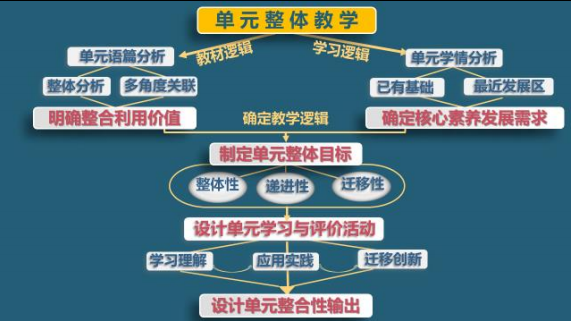

高中英语人教2019版必修一Unit4 单元原教学内容Natural disasters
课时
| 自然课时 语篇
| 语篇主题
| 页码
| | Opening Page
| Raising awareness, reducing mortality
| P47
| 1
| Listening and Speaking
| News report
| P48-49
| 2
| Reading and Thinking
| THE NIGHT THE EARTH DIDN’T SLEEP
| P50-51
| 3
| Discovering useful structures
| The use of relative pronouns
| P52
| 4
| Listening and Talking
| Safety instructions
| P53
| 5
| Reading for Writing
| Tsunami hits Asia ver 6500 dead ver 6500 dead
| P54-55
| 6
| Assessing Your Progress
| Consolidate language knowledge
| P56
| 7
| Project
| Report
| P57
| 8
| Video Time
| Killer wave
| P58
| 9
| Workbook:
Reading and Writing
| The story of an eyewitness
| P92-93
| 10
| Workbook:
Expanding Your World
| China to the Rescue
| P94
|
- 多角度分析语篇之间的关联及整体价值,基于主题意义探究整合语篇。
- 从语篇类型、语言知识、语言技能、学习策略等课程要素入手,分析语篇之间的有机关联,细化其对学生核心素养发展的价值,聚焦3个有内在逻辑关联的语篇,设计3课时的学习小单元,确定小单元对于综合发展学生核心素养的价值和教学重点,为实现单元目标提供落脚点。
表1--- 单元语篇和课时整合分配 Book1 Unit4 Natural disasters
小单元
| 课时分配
| 板块
| 语篇类型(技能)
| 语篇内容
| 页码
| 小单元I
| 第1、2课时
| Listening and Speaking
| 对话、采访(听说)
| Report natural disasters
| P48-49
| | | Listening and Talking
| 对话(听说)
| prepare for a disaster
| P53
| 小单元II
| 第3、4课时
| Reading and Thinking
| 报告文学(阅读)
| Describe a natural disaster :Earthquake
| P50-51
| | 第5课时
| Discovering Useful Structures
| 识别,填空(语法)
| The use of relative pronouns
| P52
| | | Assessing Your Progress
| 圈词(词辨),填空(语法)
| Consolidate language knowledge
| P56
| 小单元III
| 第6课时
| Reading for Writing
| 新闻报道(读写,写摘要)
| Write a summary
| P54-55
| | | Reading and Writing(WB)
| 新闻报道(读写,写摘要)
| Describe a natural disaster
| P92-93
| | 第7-8课时
| Project
| 研究展示
| Give a presentation on natural disasters
| P57
| | | Video Time
| 视频(视听)
| Watch another disaster : Tsunami
| P58
|
表2---单元内容整合和重构
- 单元结构是运用了这个大关键小观念这些观念梳理完之后,那么引导学生形成的观念是:
- 自然灾害影响危害大,要积极预防,提升自然灾害主题知识是预防自然灾害的前提条件;
表3 ---基于单元个语篇的单元育人蓝图
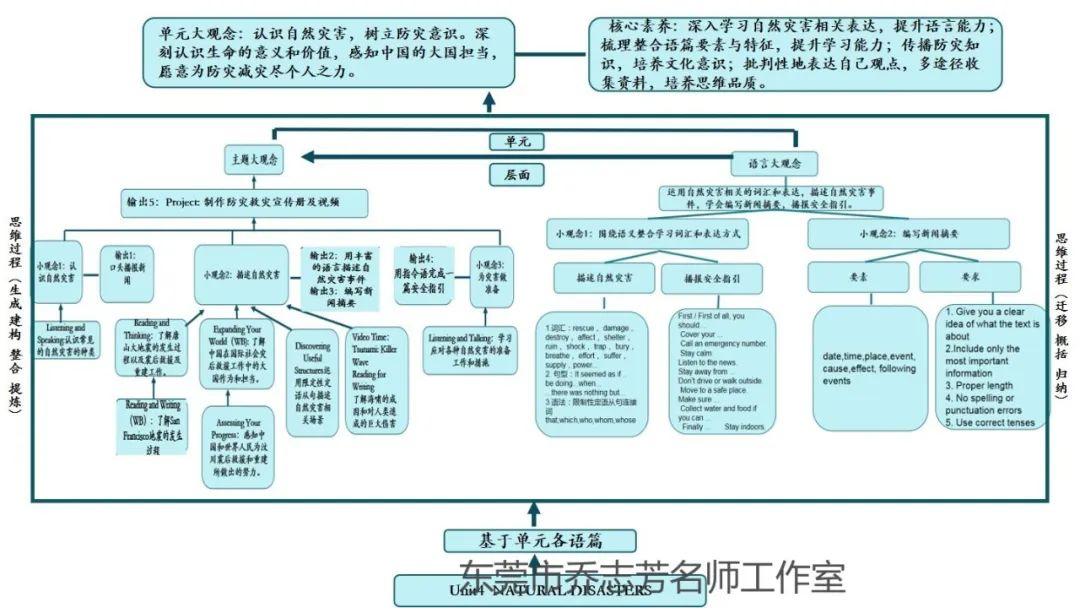
表4---单元整体教学内容分析——课时划分
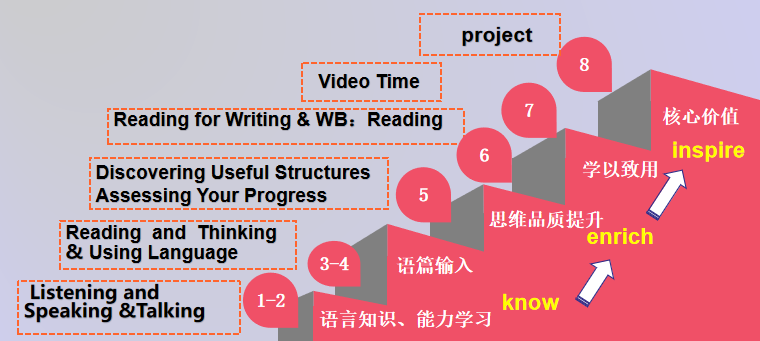
| 核心素养
| 教学目标与要求
| 语 言 能 力
| - 阅读描述重大灾害的纪实性报告文学语篇,掌握该类语篇的语言特征和叙事要点, 了解新闻播报应包含的基本要素和语言特征。
- 能分析阅读语篇的文本结构。 运用指令性语言,介绍应对各种自然灾害的准备工作和措施。
3. 能够为重大新闻事件的专题报道编写摘要。
| 学 习 能 力
| - 能根据听力问题, 预判听力内容并能提炼出关键信息, 例如:数字、时间、日期、
2. 掌握在阅读中根据上下文猜测词义的策略;巩固合成词的相关知识;能运用构词 法知识推测词义。
3. 能够将话题词归类,并有所拓展。
| 文 化 意 识
| 1. 从历史事件的角度了解国内外发生过的一些重大自然灾害,树立防灾意识和自我 保护意识;能够了解和掌握一些与自然灾害相关的安全常识和防范措施。
2. 具备积极应对灾难的意识和态度, 并能从多角度积极思考, 学习和了解相应举措, 减轻灾害造成的物质损失和心理创伤。
| 思 维 品 质
| - 能调动已有的知识和经验, 归纳、概括、整合所获信息;能按逻辑顺序组织信息;
- 能在实践中运用所学应对与灾难有关的困难,增强解决问题的意识和能力。
|
| | 必修一U4 Natural Disasters教学内容 第1-2课时 Listening and speaking &Listening and Talking
听力文本以对话形式呈现。地震救援专家Mrs Fors带着搜救犬Lucky进入学生课堂,与学生互动,在回答学生问题的同时,讲解了减少灾害损失的准备工作,以及地震发生时能够帮助自救的基本安全准则等内容。 Mrs Fors的语言条理清晰、准确而简练,使用了大量祈使句,如:“Remember to…”“ Drop down…”“ Cover …”“Hold on to…”和 “We should …”“You should…”“ You can…”等表示建议的句子来陈述自己的观点和建议。这些句式与说话人作为救援专家的身份相符,也与所谈逃生内容这个话题的严肃性契合。
单元小观念:预防灾害,做好准备
语言小观念:引导学生运用指令性语言,介绍应对各种自然灾害的准备工作和措施
教学设计
本堂课是一节听说课,教学内容是新人教版《英语》必修1 Unit 4 Natural Disasters的Listening and Speaking板块。通过本单元的学习,学生可以了解常见的自然灾害,掌握新闻报道类文体的常用时态、语言特征,最终达到学以致用的目的。
本课语篇的主题语境是人与自然,主题群是自然灾害,主题语境内容是了解自然灾害并且报道自然灾害。该部分通过听四则自然灾害的新闻报道,让学生了解自然灾害的种类以及其带来的影响,让学生学会提炼听力中的关键信息,掌握自然灾害新闻报道的特征后尝试自己播报新闻。
单元小观念:认识自然灾害,描述常见的自然灾害的种类
语言小观念:描述自然灾害并进行口头播报
Learning objectives :
To cooperate to report on the preparations of natural disasters.
- To listen to news reports about natural disasters and find out keywords and details.
- To develop a positive attitude in the face of natural disasters and discuss disaster safety measures.
- To present a brief news report with given details.
教学
环节
| 教学活动
| 设计意图
| 层次
| Lead --- in
| Activity 1
| - T asks Ss to look at the picture on the first page of ppt: What can you think of when you look at this picture?
| 引入主题:
natural disasters
| 感知
与
注意
| Activity 2
| - T puts forward the question: What natural disasters do you know?
- Ss name the pictures together: flood, drought, earthquake, landslide, hurricane, tornado, tsunami, wildfire, volcanic eruption
| 熟悉话题;
学习相关词汇;
| 感知
与
注意
| Activity 3
| - T asks Ss the question: If one of the natural disasters happens right now, what damage could it cause to us and our surrounding?
- T helps Ss conclude the expressions together:
- buildings will be damaged, homes will be destroyed, the land will be ruined, get killed or injured, get trapped or buried in ruins, people will be shocked
- T asks Ss to pay attention to the pronunciation of the verbs (-ed)
- Ss read the words together.
| 熟悉话题;
学习和伤害有关的短语;
关注过去分词的发音/d/和/t/
| 感知
与
注意
| Activity 4
| - T reminds students that the impact of natural disasters can be devastating, so it’s very important for us to know it immediately when one of them happens.
- T brings up the question: How can we get the first-hand information of natural disasters?---Through news reports.
- T tells Ss that they are going to make a news report about natural disasters in today’s class.
| 熟悉话题
明确学习
任务
| | | Activity 1
| Ss listen to four news reports and write down the natural disasters they hear in each report.
| | 感知
与
注意;
获取
与
梳理
| Activity 2
| Ss listen to four news reports one by one and fill in the blanks.
(T has to give Ss time to read before listening)
| - 通过听力,培养学生listen for details 的能力; 帮助学生深度理解听力文本的内容
| 获取
与
梳理
| Activity 3
| T asks Ss to take a closer look at the first report and conclude the aspects covered in a news report:
time, place, disaster, damage and rescue.
| 帮助学生总结新闻报道的5个要素
| 概括
与
整合
|
Post-listening
| Activity 1
| - Ss choose one report and practise retelling with their partner.
- Ss present their reports in class.
| 运用表格中的信息,复述新闻报道的内容,初步尝试做一个新闻报道
| | Activity2
| T plays a real news report and asks Ss to pay attention to the news language used in it.
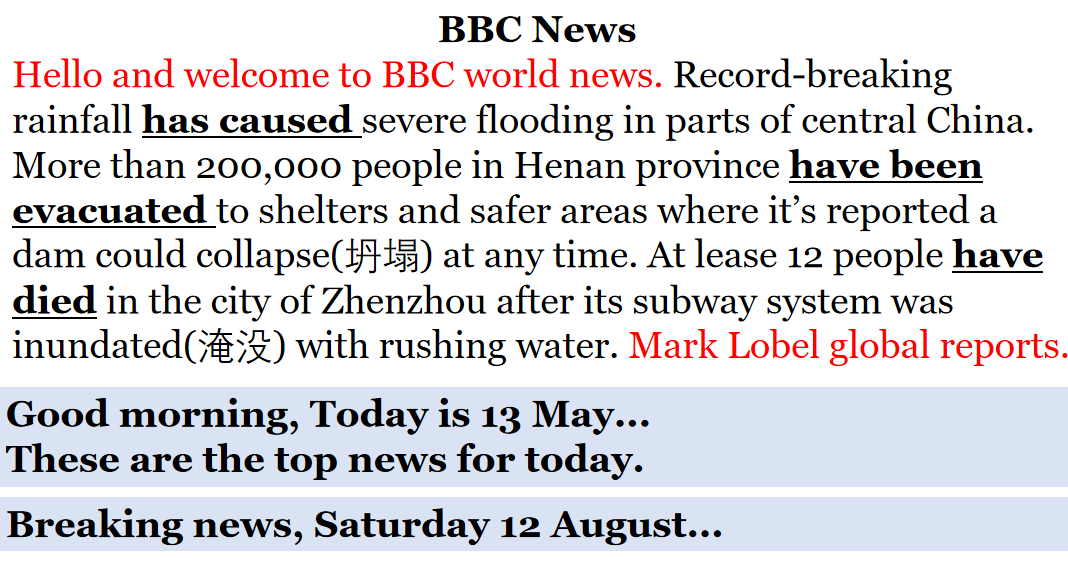
| 引导学生关注新闻语言以及其中运用的时态和语态
| 感知
与
注意
| Activity 3
| Ss prepare a short news report on one of the disasters on page 49 and practise oral reporting with their partners.
(It’s necessary for teachers to teach new words first)
Ss deliver their oral reports in front of the class.
| 运用所学知识,输出对自然灾害的报道
| 内化
与
运用
| Activity 4
| T puts forward the question: What was your first thought when listening to these news reports?
(possible answers: shocked, sad, lucky...)
T asks: what if natural disasters happen to us one day? How can we protect ourselves?
Ss discuss in groups.
T leads Ss to read together: “We cannot stop natural disasters but we can arm ourselves with knowledge.”
| 引导学生进行对自然灾害的深度思考(raise awareness)
| 批判
与
评价
|
Listening and speaking 课时输出:
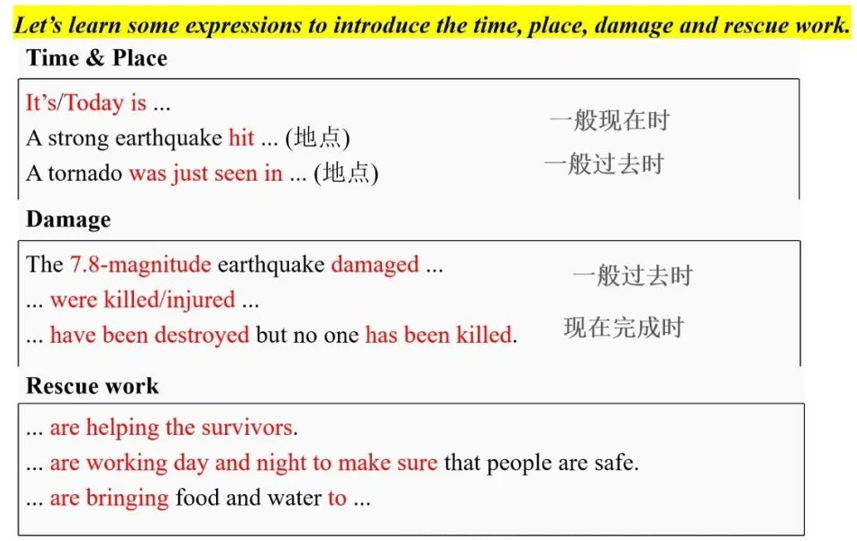
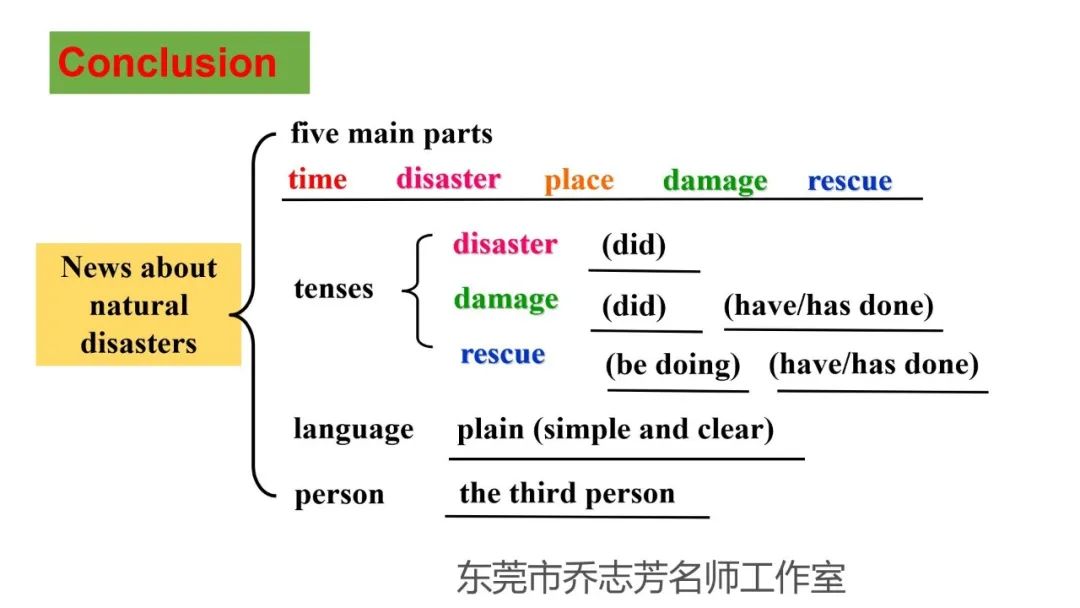
小结:
本课听说能力的培养策略,贯穿整节课,听说结合,读听结合,听读说结合。
听前的活动,激活主题背景知识,合理设计任务,针对性的设计精听活动,发展判断意识,突破难点。
对于基础薄弱的学生,帮助他们认识和理解基础词汇句子和文章,多朗读文章重点的重点短语、句子和段落,使用教材中的短语和句子尝试说英语。
Homework:
Gather information from the Internet and make a poster in pairs to introduce the disaster safety measures and your emergency supplies.
从网上收集信息,制作海报,介绍灾害安全措施和你的应急用品。
| 必修一U4 Natural Disasters教学内容: 必修一Unit4 第3--4 课时Reading and Thinking
教学设计
主题语境:自然灾害-增强减灾意识,减少人员伤亡
语篇类型:灾难新闻报道
教学基本信息
| 课题
| 人教版高一英语必修1 U 4 Earthquake Reading and thinking: A Night The Earth Didn’t Sleep
| 指导思想与理论依据
| 根据课标任务驱动教学法的原则,在教学过程中注意老师的“教”与学生的“学”相结合。设课环节考虑到学生在活动中发挥主导地位。在设计活动时,利用多媒体教学,将本堂课分为3个部分。任务设计简明易懂。通过开展师生互动,生师互动,生生互动等课堂活动,让学生在完成任务的过程中探究、合作和交流,逐步实现教学目标,培养学生的自主学习能力。
| 教材分析
| 本单元的中心话题是“地震及自然灾害”,是一个学生常听的一个话题,介绍震前、震中、震后发生的事情。层次比较明确,比较易懂,但此文本为报告文学(Literary journalism),是一种介于新闻报道和文学作品之间的文体,其中运用的多种修辞手法需要帮助学生进行梳理。
| 学情分析
| 高一学生英语,有一定的英语学习基础,基础好的能流利表达观点,一些基础较弱的只能说出一些单词,不能完整的表达。但学习习惯还是可以的,会和老师配合互动,关于后面的讨论,要求较为丰富的交叉学科知识。
| 教学目标
| Teaching objectives
1、学会有关地震的知识,并能熟练运用阅读技巧。
2、懂得“地震无情人有情”的仁爱情怀、人文情怀;培养学生“一方有难、八方支援”的互助友爱、家国情怀。
单元主题:主题语境是人与自然
主题群是重大自然灾害之一--地震
主课语境内容是构建学生关于地震话题的阅读链
本单元通过四个语篇的群文阅读,让学生了解地震来临之前的异常征兆、地震发生时极具摧毁力的破坏、震后救援和重建以及中国在地震中体现出的大无畏、大爱精神以及大国担当。
语篇一:Reading & Thinking了解唐山大地震的发生过程
语篇二:Reading & Writing 了解San Francisco地震的发生过程
语篇三:Expanding your world(WB)了解中国在国际社会灾后救援工作中大国作为和担当
语篇四:Assessing your progress 感知中国和世界人民为汶川震后救援和重建所做出的努力
单元小观念:描述自然灾害
语言小观念:围绕语义整合学习词汇和表达方式
Unit 4 NATURAL DISASTERS以“自然灾害”为主题,从认识自然灾害的种类开始,到了解近现代历史上国内外发生过的重大灾害事件,再到探讨面对灾害的威胁和所造成的损失时,人们如何采取应对措施等,让学生重视自然灾害,树立防灾意识,体会“灾害无情,人有情”的大爱精神。
学情分析:
本单元面向高一年级学生,他们英语学习热情较高,有较强的表现欲望。英语基础水平虽然一般,但是英语学习兴趣较强。学生在课前通过网络媒介对重大地震实践有所了解,但是缺乏相关主题文本的渗透,所以对地震相关知识的了解呈现碎片化的状态。其次,学生刚刚从初中学过渡到高中阶段的学习,相关的阅读略和技巧尚未完全形成,需要老师在阅读活动的过程中进行点拨和指导;最后,学生思维非常活跃,但由于语言能力和思维层级的受限,在语篇阅读的输出环节会遇到较多障碍,需要老师给予足够的辅助。
Teaching procedures
- Skill objectives:Strengthen students’ skimming and careful reading skills.
Have students know what to do in an earthquake.
- 1) Make students understand the main idea of this reading and each paragraph.
2) Make students master some knowledge about earthquakes.
3、Emotionobjectives:live to Tell: Raising Awareness, Reducing Mortality。
| 教学重点和难点
| 教学重点:1)了解文章大意,获取震前、震中、震后的信息,使学生提高英语阅读能力;
2) 通过阅读本篇文章,使学生了解地震所带来的巨大危害,知道灾难来临时应如何应对。
教学难点: 本篇报告文学中的两条线索脉络,明线时间线和暗线情感线的交织。
| 教学环节
| 教师活动
|
设计意图
| Step I
Pre-reading
| - Show a piece of voice about the Tangshan earthquake.
Guess,what is it?
- Show the video about the Tangshan earthquake to prove
| 由声音的预测切入视频,由此来引出本文话题。
| Step II
Reading
| Skimming
Skim the passage .
Task1.
Q:
1).Where did it happen?
Task 2.
- Main idea of each paragraph.
2)Scanning
Pat I: Before the earthquake
Match verbs with these 4 parts(village well, animals, the sky, people).
Part II---para. 2—3 uring the earthquake uring the earthquake
Circle all of the numbers and fill in the form.
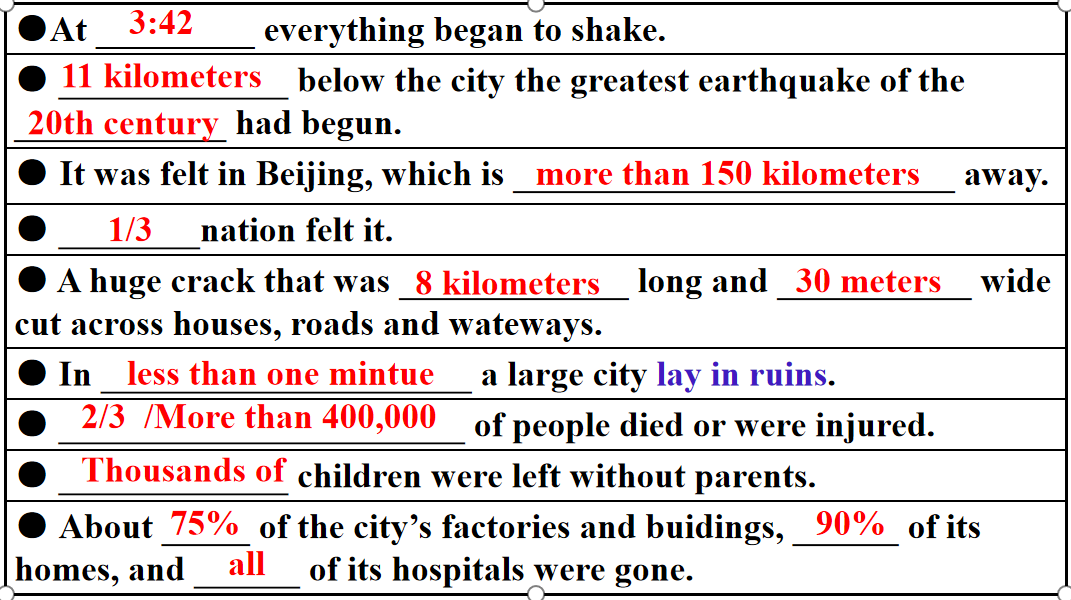
Q: Which number give your deep impression? why?
Part III---para 4-5 After the earthquake
Q:
1) Who came here?
- Work in pairs, retell Tangshan earthquake.
- (before-during-after or signs-damage-rescue)
| 1.快速捕捉新闻播报中关于earthquake整体信息的能力,和之前的listening&speaking做好衔接;
2.找寻每段的topical sentences,帮助学生树立如何找寻主题句的能力(通常是第一句或最后一句)。
3,通过把地震划分为三个阶段,让学生明白文本以时间顺序展开。
- 关注数字,使学生提炼两个词:suffering,serious,同时关注事件发展线由down到up,情感线从hopeless到hopeful的过程。
| Step III
After reading &thinking
| - Why was the earthquake in Tangshan so serious ?
- Why did Tangshan revive quickly at that time?
- How to protect yourself in the earthquake?
- Raising awareness, reducing mortality.
| - 帮助学生再次回顾细节,引发学生独立思考能力,探究事物现象背后的本质,总结唐山能够重建和复兴的原因。调动学生学科知识的交叉性。
| Step V
Homework
| - What’s the rhetoric of these sentences?
- 1. Water rose and fell, rose and fell.
- 2. A night the earth didn’t sleep.
- 3. Slowly, the city began to breathe again.
- 4. Bricks covered the ground like red autumn leaves.
| 在老师讲解前先理解一下本文的多种修辞手法,为下节课讲解报告文学(Literary journalism)做好铺垫。
| 板书设计
| A Night The Earth Didn’t Sleep
- Before--During--After signs--damage-- rescue
| |
Fill in the blanks according to the text.
Homework Tangshan Earthquake
| Before the earthquake
| ·The water in the village wells ①rose and fell again and again.
·Animals in the farmyards became too ②nervous to eat.
| During the earthquake
| At 3:42 am everything began to ③shake.
And hard hills of rock became rivers of ④dirt.
| Damages of the earthquake
| Over 400,000 people were killed or ⑤injured in the
earthquake. And nearly everything was ⑥destroyed.
| The help from the
whole nation
| Soldiers dug out those who were ⑦trapped and buried the dead. Medical workers came to provide medical ⑧care. Workers built
⑨shelters for survivors.
| The great success people
have achieved
| The new city has taken on a new look, with great
⑩improvements in transportation, industry, and environment.
|
| | 必修一U4 Natural Disasters教学内容: 第5课时Discovering Useful Structures-AssessingYour Progress
一、教材分析
本课的活动主题为用涉及关系代词的限制性定语从句描述地震相关的图片。如果使用正确得当,限制性定语从句不但可以丰富语句与语篇内容,而且可以使得描述更加形象更加具体。本节课中,学生应掌握限制性定语从句关系代词的用法,并且使用限制性定语从句来描述与地震相关的图片与组织。本课活动的设计是依据“感知与发现—总结与练习—迁移与应用”的步骤。通过这些活动,学生可以逐渐理解限制性定语从句的形式、意义和功能,然后应用其所学来描述某些人或物。“whose”和“介词+关系代词”是学生比较不熟悉的,所以学生要特别注意。
二、学情分析
授课对象为高一年级学生,大多数学生英语学习已经有较长时间,基础的英语语言知识和语言技能过关,具备了不同句子中归纳出语言特征和语法现象的能力,能够总结出语法知识的基本形式。但是,学生对语法现象存在的意义了解并不透彻,不清楚包含定语从句的主从复合句与并列句之间的表意差异,此外,学生在初中已经接触过定语从句,但是对于定语从句中所涉及到的一些术语,清楚称呼,但对于称呼的含义、功能、成分等还停留在表面,并没有真正了解。
三、学习目标Learning objectives
1. Help the students recognize the restrictive relative clauses (定语从句) and understand the use of relative pronouns (关系代词);
2. Guide the students to summarize the form and functions of restrictive relative clauses;
3. Enable the students to use restrictive relative clauses to talk about pictures and organizations related to disasters.
Teaching procedures
Step one Revision
From the text THE NIGHT THE EARTH DIDN’T SLEEP, we know that
an earthquake happened in Tangshan on July 28, 1976.
1. Can you use an adjective to describe the earthquake?
and we also know that the earthquake caused great damage to Tangshan.
2. Which earthquake are we talking about?
Conclusion:
1. 定语从句的概念:
2. 定语从句的构成:
The earthquake that happened on July 28, 1976 caused great damage to Tangshan.
3.为什么使用定语从句?
The earthquake caused great damage to Tangshan.
The earthquake that happened on July 28, 1976 caused great damage to Tangshan.
Step Two Discovering
Task 1 Find and underline the restrictive relative clauses in the sentences below. (P 52)
Task 2 Find more sentences with restrictive relative clauses from the text on page 50
and underline them on your book.
Task 3 Find out the relative pronouns and summarize the usage of them.
1. ... a terrible experience that my great grandma cannot forget.
2. The supplies which were provided to the disaster area ....
3. ... cracks that appeared in the well walls.
4. The couple who live next to us ....
5. Two thirds of the people who lived there ....
6. ...dig out those who were trapped and to bury the dead.
7. Mr Li is an architect whose designs for the new town ...
8. Workers built shelters for survivors whose homes had been destroyed.
9. A doctor with whom James used to work ....
Compare
1. Mr Li is an architect whose designs for the new town have won praise.
Mr Li is an architect and his designs for the new town have won praise.
2. Workers built shelters for survivors whose homes had been destroyed.
Workers built shelters for survivors. Their homes had been destroyed.
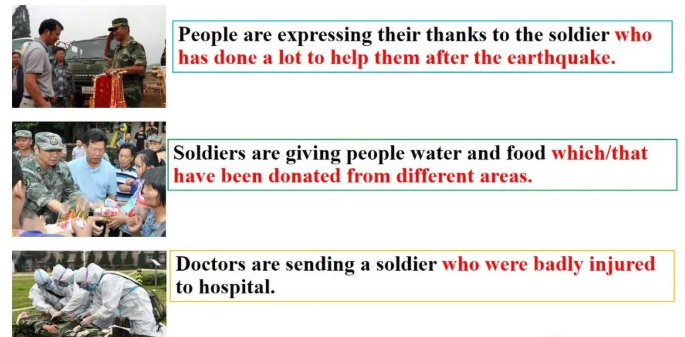
Then finish the table below:
Step Three Practice
Task 4 Complete each sentence with that, which, who, whose, whom or “/”.Then choose the right translation.(Student’s. Book , P52, Exe2.)
A. 建筑物可怕的摇晃把人们从睡梦中惊醒。
B. 有些人的家园被台风摧毁了。
C. 第二天,人们用能找到的一切物品在空地上搭建起避难所。
D. 这就是那个从楼里救出了好几位被困同学的男孩吗?
E. 这位女士给营救她的战士写了一封感谢信。
F. 那个在灾难中失去了母亲的受伤男孩被送去了医院。
G. 几天以后,大多数被飓风破坏的建筑物得到了修缮。
Task 5 Use a restrictive relative clause to combine each pair of sentences.(Exe. Book, P90 Exe2)
__________________________
Task 6 Take turns to ask each other about the pictures. Make sentences with restrictive relative clauses using that, which, who, whose, or whom.(Student’s. Book , P52, Exe3)
Step Four Self-assessment.
Assess your achievement by answering the following questions:
1. What is a restrictive relative clause?
2. Where is it used?
3. Why do we use it?
4. What are the relative pronouns and when can we use them?
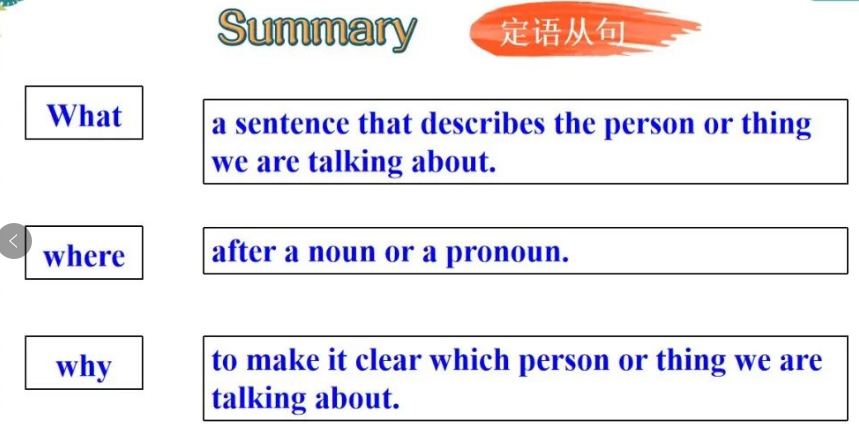
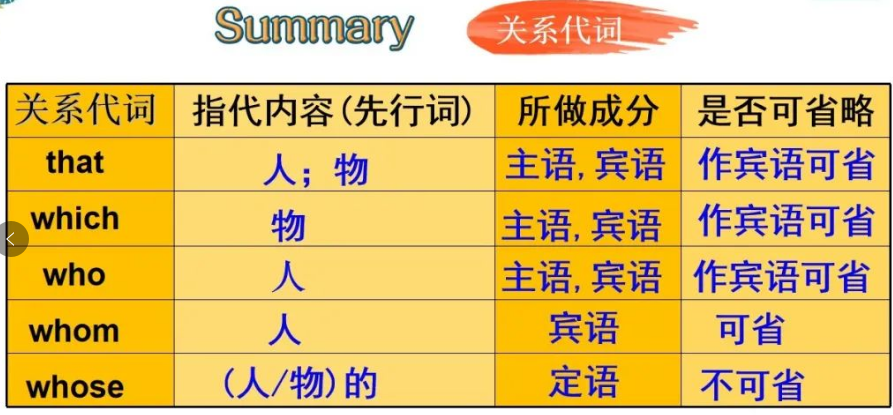
Step Five Homework
Write 3 or 5 sentences to describe the people or things around you by using restrictive relative clause.
| 必修一U4 Natural Disasters教学内容 第6课时Reading for Writing & Reading and Writing(WB)
一 、教材分析
本课例选自人教版高中新教材必修一Unit4 Natural Disasters 单元Workbook中的Reading and Writing ——The Story of an Eyewitness。本单元的主题是“人与自然”, 涉及话题为“自然灾害”。过去的三年年是一个灾难和希望并行的不凡之年,人们在这三年里经历蔓延全球的新冠病毒,目睹了澳大利亚森林大火,东非蝗灾,菲律宾火山,以及多地的暴雨及大暴雨等种种自然灾害。然而,在灾难肆虐的同时,人类也体会了许多人间的大爱,那种跨越国界、跨越种族的互帮互助和同舟共济;体会了生生不息的希望,那种在绝望失望中依然不曾被毁灭的星光之火。
本单元旨在告诉我们:当人类面对自然灾害威胁时,尽管有些超出了我们的预测能,我们人类会产生一种无力感,但是,我们还是应当树立防灾意识,不断增强我们的认知水平,研究和认识各种自然灾害,努力提高自身的防护能力和生存能力。当灾难真正发生时,我们除了有自救的能力,也拥有救人的能力。
二、学情分析
本节课的教学对象是高中一年级的学生,由于学生在高中阶段刚刚起步,对于专题新闻还是比较陌生,因此在教学上要让学生在了解文本的基本信息和框架,了解专题新闻的语言特点,弄清文本细节阅读等方面下功夫。同时本单元的活动主题为摘要写作,此前从未接触过此类练习,学生有着畏难情绪就在所难免。要让学生读懂文本的同时写出摘要,就要培养学生的提炼关键信息以及概括、归纳要点的高阶思维能力。同时还要培养和提过学生分析、归纳、总结等思维能力的方法,这对于师生都是一次不小的挑战。
三、学习目标
To read the news report to find out five Ws and one H; identify main points of a news report.
To organize the structure of a summary.
To write a summary.
Teaching procedures
- Teacher shows picture 1 .
- What disaster is it? ( Tsunami )
- Teacher shows picture2. What is tsunami ?
- A tsunami is a series of waves caused by earthquakes or undersea volcanic eruptions.
- What’s the genre of the text?
- What are the features of news report?
Ⅲ. Before Reading
- Read and find out the five Ws and one H of the reading material:
- What’s the genre of the text?
- What are the features of news report?
1. Watch a video and tell me what happened in it?
___________________________________________
___________________________________________
2. If you want to report the event, what key elements should be included?
____________________________________________
____________________________________________
设计意图:通过视频导入本课内容即海啸的主题报道通过视觉冲击和记录片播音员的解说,让学生更加真切地感受灾难来临的可怕和造成的严重后果,并据此引出报导时要呈现哪些关键信息点,如时间、地点、原因等。
IV. While Reading
Activity 1: Reading for structure and the main idea of the body part.
The structure of the news report includes: ______________________________________________.
Para.1________________________________________
Para.2________________________________________
Para.3________________________________________
设计意图:学生通过阅读文本,能够归纳出每段的段意,着意培养他们归纳分析的能力,为本单元的写作打好坚实的基础。
Activity 2: Reading for the details
Read the news report in 3 minutes and then solve the questions below.
1. When did the tsunami happen?
_________________________________________
2. What caused the tsunami?
_________________________________________
3. Why would it be difficult to deliver food and supplies?
_________________________________________

设计意图:学生在掌握文章脉络的基础上,以任务型教学为驱动,通过设计一些细节信息,推理性问题对文本信息逐层深入设问,这不仅使学生加深了对问题的深入探究,同时有效的提升学生的阅读技能。通过对文本细节化的分析,让学生总结和掌握新闻摘要的要点:日期、地点、起因、可能的后续活动等。让学生进一步关注新闻报道地要点,通过回答一系列地问题让学生完成上表里的信息,更好地为概要写作打好基础。
IV. Post Reading ---- Reading for writing: learn to write a summary.
1. What is a summary?
_________________________________________
2. Read the steps of summary writing and keep them in mind.
_________________________________________

My summary of Tsunami Hits Asia: Over 6,500 Dead
__________________________________________
__________________________________________
__________________________________________
__________________________________________
设计意图:让学生初步了解什么是概要写作。归纳出概要写作的步骤,让学生了解这些步骤。并通过步骤引领,让学生化解概要写作的畏难情绪。让他们意识到概要写作的语言要简明扼要且要点齐全。原报道中的大量数字、被采访者的话语均要被省去。同时引导学生尽可能用自己的语言进行表达,不要照抄原文的词句。
V. Homework
Polish your summary you wrote in class.
Find an article to write a summary by yourself.
Black board design :
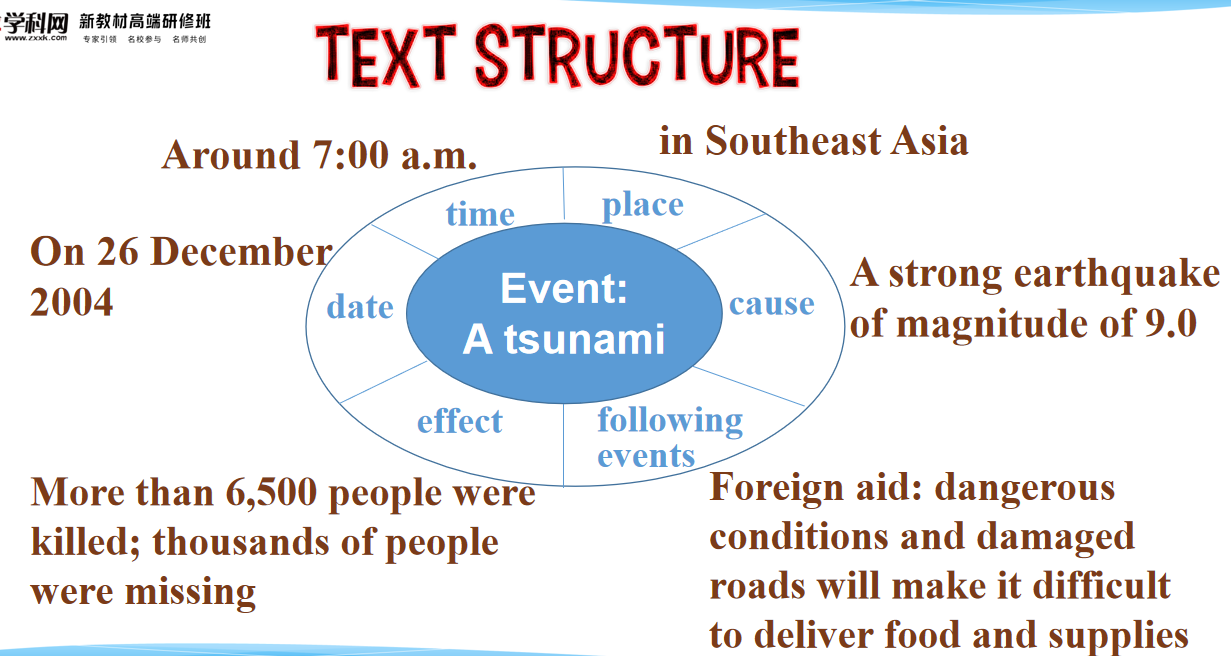
优点 : Black board design; 评价表格 Evaluation form
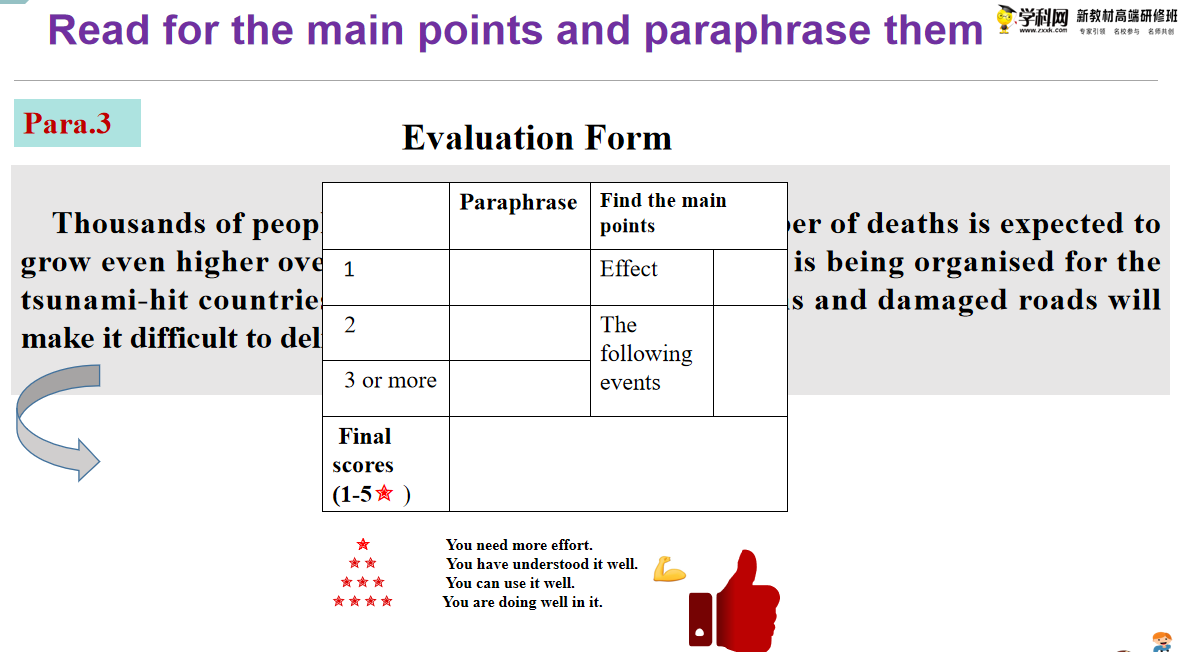
| 必修一U4 Natural Disasters教学内容 第7课时Video Time
Learning objectives:
Watch the video to know about tsunami.
To be able to describe the process of a disaster by watching the video.
To talk about the safety instructions about tsunami.
Discuss on the relief work after tsunami.
Teaching procedures
Step I. Warming up
What is tsunami?
What Causes a Tsunami?
Step II. Lead in
Tsunami: Killer waves
Tsunami waves can strike out of nowhere and cause a lot of destruction. Scientists study and track tsunamis in order to warn people and minimize deaths.
What should we do when a tsunami hits?
Do you know some safety instructions?
Step III.Before you watch
Read the sentences about the formation and effects of tsunamis. Then match each sentence with the correct picture.
Picture 1-- C ; Picture 2-- A ;Picture 3-- B
Step IV.While you watch
(1) The main character_______
(2)The key event ___________
(3)The result of it is_________
2. Match the two columns with the similar meaning.
3.Decide whether the statements are true(T) or false(F).
Step V. After you watch
Work in pairs. Discuss the questions.
1.What have you learnt about tsunamis?
2.What kind of help do you think people who have suffered from a tsunami need?
Step VI. Homework
1. Choose a natural disaster that interests you the most.
2. Gather information about it (the cause, the effect, the safety instructions...).
3. Make a poster to introduce the disaster.
| 必修一U4 Natural Disasters教学内容 第8课时Project Give a presentation on natural disasters
语篇分析
本课的主题语境是人与自然,主题群是灾难防范,主题语境内容是自然灾害与防范,安全常识与自我保护。Project的内容是“做一个关于自然灾害的报告”。要求学生综合运用和整合单元所学知识,围绕某一自然灾害,遵循 Brainstorm-Research- Organise-Present 的步骤,以小组形式完成报告的任务。
学情分析
本课的授课对象是南昌县莲塘第一中学2020级高一年级学生,课例录制时间是2021年6月,学生还没有使用新教材,根据授课需要印发了Listening and Speaking, Reading and Thinking, Listening and Talking和Project四个部分的课文给学生,在上本课之前,利用一节课的时间处理了前三个部分中的Listening和Reading,其余部分只进行了简要的说明,作为学生写报告的参考资料,小组自主学习和讨论。另外,经过高一一年的学习,学生具备小组合作的经验、制作课件和在网络平台查阅和下载资源的信息技术能力。
教学目标:
在本节课学习结束时,学生能够:
1. 从成因、影响、预防、准备、安全措施及救援措施等方面对自然灾害进行陈述;
2. 了解并运用报告的特点组织小组收集的关于灾难的信息并进行汇报
教学重难点
1. 重点:通过回顾本单元学习地震的过程,引导学生自我归纳提炼如何做关于自然灾害的报告。
2. 难点:学生在与灾难相关的知识和语言表达方面的储备欠缺。
教学资源:教材,多媒体课件,视频,手绘图,黑板,粉笔

To discuss the natural disasters you know.
To learn steps of preparing for a presentation on natural disasters.
To give a presentation on natural disasters to your class.
To be able to describe the process of a disaster by watching the video.
Teaching procedures
Step I.warming up
What kind of natural disasters can you think of?
Step II. Brainstorm
Work in groups of three or four. Choose one of the natural disasters above and brainstorm answers to the questions.
Step III. Understanding the disaster
Are there any known causes of the disaster?
What can be done to prevent it?
Wildfires are usually caused by human and natural factors (lightning, etc.).
Forest managers should be hired to protect the forest and people should be educated about prevention of forest fires.
Earthquakes are caused by tectonic plates shifting.
Step IV.Preparing for the disaster
What are the possible effects of the disaster?
What can be done to prepare for it?
Check your home for areas that may be weaker in an earthquake. Also look at your things; for example,
furniture such as a wardrobe which is not attached to a wall may fall easily, and glass on a high shelf could be dangerous. Also find the safest area too.
Step V.Project research
Which questions do you not know the answers to?
Which ones do you need more information on?
Use the Internet or your school library to find out more.
Step VI.Organize
Put together a presentation using the information you have gathered. Use the tips to help you.
Step VII.Presentation
Give a group presentation to your class.
show time : Who is the best reporter ?
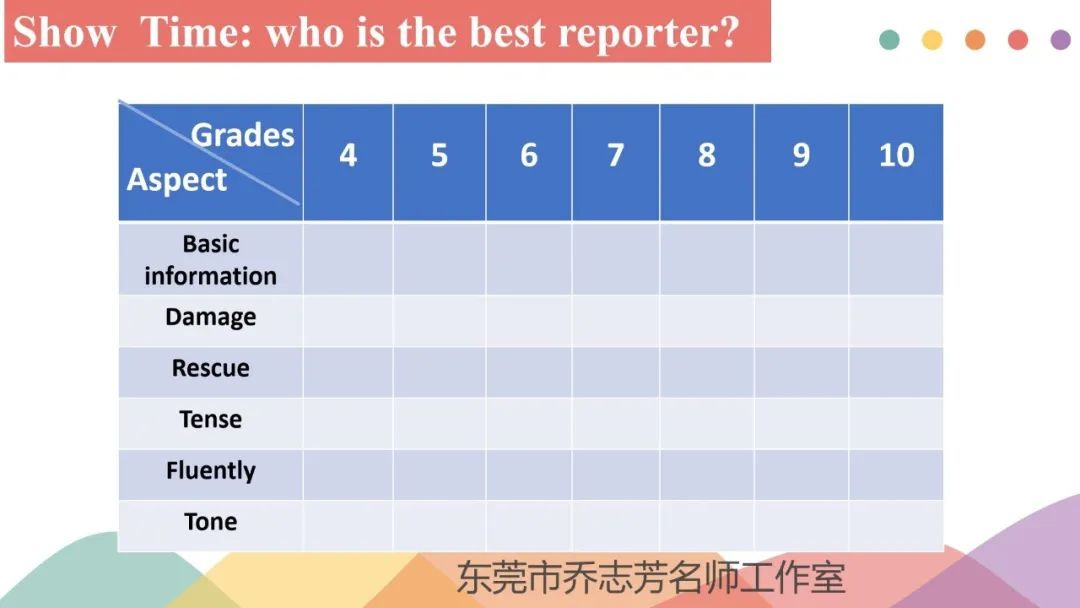
Step VIII.Homework
1. Choose a natural disaster that interests you the most.
2. Gather information about it (the cause, the effect, the safety instructions...).
3. Make a poster to introduce the disease .
教学反思 project
本节课是该单元的第8课时,要求学生综合运用和整合单元所学知识。围绕某一自然灾害,以小组形式完成报告的任务。
课例亮点在于利用单元本身的课本语篇引导学生分析和归纳应该从哪些维度来完成对于自然灾害的报告。在回顾单元listening和reading部分时,还一同复习了相关语言表达,比如listening and speaking部分的新闻播报语、listening and talking 部分的指令语,进一步为学生的输出做足铺垫和指导。另外,小组展示期间,用于记录小组介绍自然灾害内容的study sheet有利于培养学生倾听和尊重他人的良好习惯和在听的过程中,抓住语篇大意、获取主要事实、观点和文化背景的能力。
学生方面:在完成项目任务的过程中,学生体现出来的自主学习和团结协作能力较强。由于这届高一学生是使用老教材,且课时紧张,授课教师无法完整上完前五节课再来开展本节课的教学任务,所以在花费一节课学习了听力和阅读的主语篇后,其他资料都是学生自主讨论和学习。根据课例后半部分学生的展示可以看出,学生能够做到客观分析学习材料、确定调查对象、明确分工和有效组织小组学习活动。展示形式多样化,有PPT课件、视频,其中有一组发挥组员特长绘制了思维导图。还有一个很大的亮点就是与自然灾害相关语言表达得到了提升。学生自主解决遇到的语言表达问题,积累了较为高级的词汇如deforestation、excessive emission等,在课本原有的语言知识基础上增加了新的储备。
不足之处:1.由于没有完整上完前面的课时,一些单元词汇和语法的语言使用还不是很到比如定语从句。2.当时考虑到每个小组都辛苦准备了很长时间,查找资料和制作PPT,所以想让他们都有机会展示,结果导致课时过长,并且压缩掉了学生评价的环节。过程中一直都是老师带着学生一起对内容进行评价,老师说得过多了。后续改进考虑展示2-3组,留足时间让小组对报告进行讨论和评价,教师给予评价表,还可以考虑评选最佳课件小组、最佳信息查找小组等。
课堂活动组织参考:
小组角色扮演:老师将班级分组后(注意学生水平强弱搭配),可以提前把资料提前发给学生,然后分小组进行演绎整场访谈节目;
分角色小组合作:老师按照学生水平和复习知识点的难度想匹配,把学生分为自然灾害专家组,地震经历者小组,洪水经历者小组和山火经历者小组。
以小组合作的形式完成复习任务,这样的形式还能与分层教学相结合,让学生更好的参与课堂活动。
多种形式具有关联性实践性的单元学习活动,主题内涵,表达主题一下信息的多元视角。
Conclusion and thinking
When faced with the disasters, what should we do ?

设计意图:通过本文的学习和写作,让学生形成积极面对自然灾害的理念,让他们形成“灾害无情人有情”的主题探索,即人类在重大自然灾害面前不屈不挠,相互援助,坚定信息,重建家园的决心。呼吁人们重视自然灾害,树立防灾减灾意识。
| | - What are natural disasters?
- What are the causes of natural disasters?
- What kind of natural disasters are there in our life ?
- What were the strange things happening before the earthquake?
- What were the effect of the earthquake on people there ?
- Who came to rescue ?How did the rescuers help the people there ?
- Which part impress you most ? Why ?
- What do you think helped in the revival of Tangshan city ?
- How can you promote natural disaster-related knowledge to people
- and increase people's awareness ?
- 3.抓住文本的数字化特点,展示语篇数字风格。反衬地震带来的灾害。
4.领会文本的修辞特点。
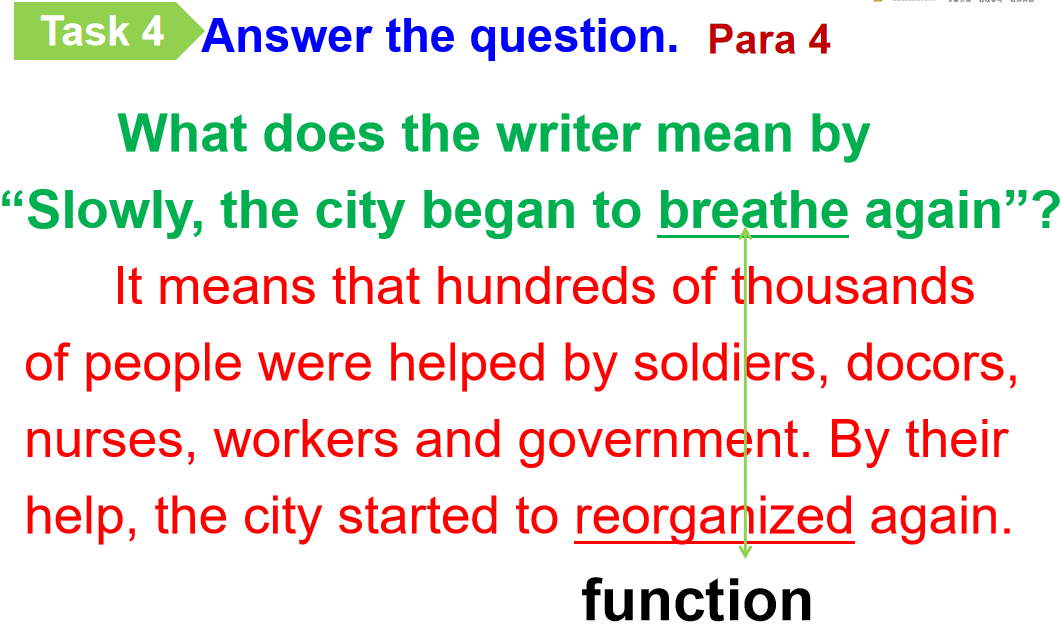
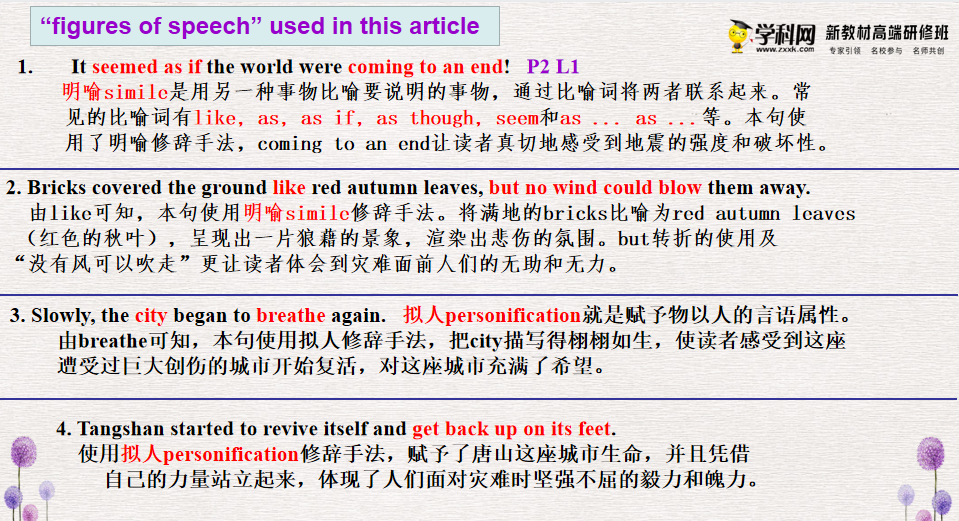
6.对文本进行概况性的分析总结。
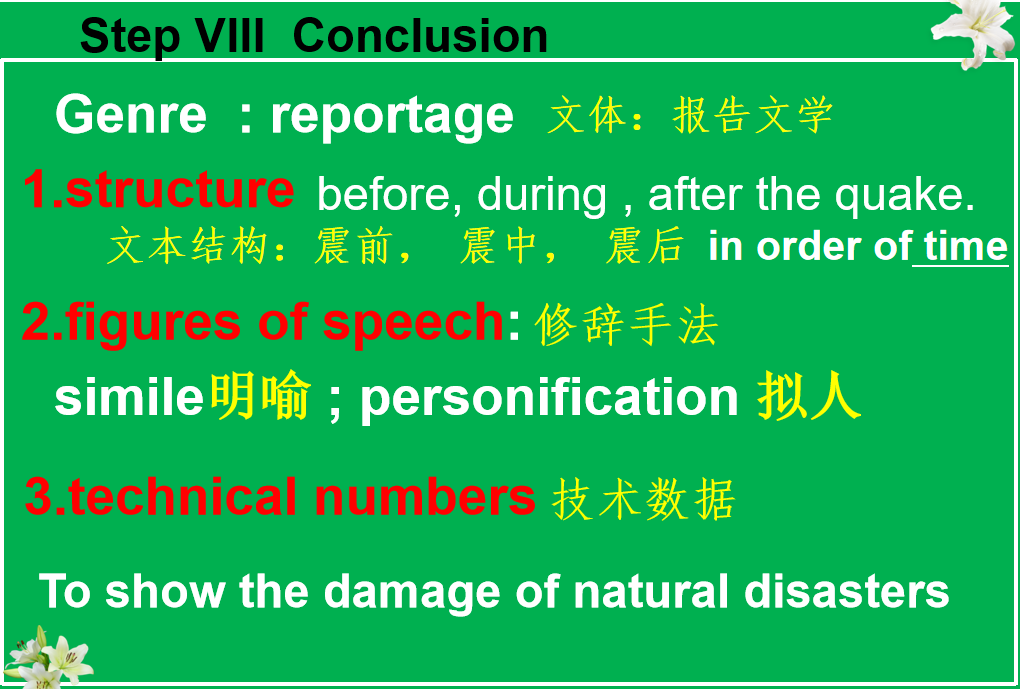
- 新疆向中国、向世界证明,在抗击新冠肺炎的战疫中,人类必须同心协力,保持积极乐观的心态和战胜病毒的决心 。 我们一定可以打赢这场抗击疫情的战争。
- Xinjiang has proved to China and the world that in the fight against COVID-19,humans must work together to stay positive and hold the determination to beat the virus. We can definitely win the war against the epidemic.
8.设计真实场景活动,从而产生敬畏自然的意识
新闻播报——学习的情境,真实的情境驱动学习的热情,挑战学生发展。
PBL 项目式学习始终贯穿本单元教学,Project-Based Learning (PBL)的理念是打通学科限制,以学生为中心,以解决某个现实问题为 出发点,让学生发现问题、合作、思考、实践、展示、评价和总结。它强调学生在解决实际问题中学习,教师作为课程搭建和指导者。学生自主学习,教师辅助指导。
在我们生活的地方,地震、泥石流、融雪性洪水,山体滑坡、雷电、沙尘暴、霜冻、火灾是新疆最常见的八大自然灾害。通过 PBL 项目式学习引导学生了解症状,实施监测预警,进行风险评估。通过自然科普内容,图片,文字、海报、视频进行宣传,提高市民的防灾减灾意识和能力。同时要引导学生理解并懂得敬畏自然、珍爱生命和防范于未然的道理 。
要实现单元教学的整体性,促进学生多维素养的融合发展,单元学习活动形式和内容的延续性很重要。在单元教学中,连续利用同一种形式的活动能够保障学生在语言能力上持续、深度的发展。不同层次的活动可以循环往复,迁移创新不一定是最终目标,学生在迁移创新时反思、明确自己的发展需求,进而回看、复习单元学习的内容,可能又开始新一轮学习理解、吸收内化的过程。
学习过程和评价
核心素养
| 评价内容与要求
| 语言能力
| 主题
| 自然生态保护--引人入胜的公园
| | 词汇
| 能够正确使用本单元的重点单词和词块,掌握常见的构词法:派生,合成,转化。熟悉常见的词根与词缀
| | 语法
| 理解动词-ing形式作主语的功能和意义;能正确运用该形式描述具体的行为或习惯
| | 语篇
| 理解并能欣赏游记中常用的叙述方式和语篇特点,语言特点
| | | 掌握介绍主题公园的宣传文稿这种语篇类型应具备的要素和常用表达手法
| | | 掌握游记信函语篇中对景点的描述以及从旅游计划、旅游经历到旅游感受的语篇结构发展
| | 表达
| 能够就方位,地点信息组织语言开展对话交流
| | | 能够模仿范文,结合公园主题,有条理地介绍公园并说明意义价值
| | | 掌握旅游明信片的表达特点及写法
| 学习能力
| 1
| 能够快速获取语篇主要内容,概括语篇中的段落大意
| | 2
| 能够根据方位关键词,听取并理解相关的信息,并结合地图提示,快速确定游玩路线
| | 3
| 运用构词法学习词汇,积累词汇
| 文化意识
| 1
| 了解并欣赏国内外著名的国家公园、城市公园、主题公园,拓展国际视野,厚植爱国情怀,提升文化自信
| | 2
| 能够从人和自然、人和社会的角度探索公园存在意义和价值,以及公园的人文内涵,能够思考人和自然的和谐共处的理念,树立人类命运共同体的理念。
| 思维品质
| 能够抓住要点,对比和理解不同类别或同一类别的不同公园所具有的特点,区别和共性,探寻和理解事物表象之下蕴含的深层含义,批判性思考经济发展与自然保护的关系
|
- 1. 在本节课的教学中,将文本阅读与概要写作相结合,创设各种情境,并根据教学目标结合学习内容,设计贴合教学目标的任务,在提供大量信息输入的前提下,保障学生有足够的输出机会。
- 2. 整节课我采用了单元整体教学法、情境教学法、任务教学法等多种方法并注重教学各环节的连接。始终以学生为主体,灵活运用多种方式完成任务。坚持任务型教学驱动的原则,设计了各种活动和讨论、反馈和书面落实,层层铺垫,环环相扣,讲练结合,小组合作探究展示,有效实现了知识到能力的正向迁移。
- 3. 小组合作学习的方式提高了学生的合作意识和能力,使学生在活动中相互合作、共同探究并解决问题,有利于学生形成完整的知识结构,培养了学生的发散思维和创新思维能力。
- 4. 在今后的教学中,我会更好地把控讲与练的时间,以学定教,学为主导,给予学生更多的自主探究和展示的空间。
- 本文通过数字对比的英语学习活动观,分析出全文描写生动,饱含情感,体现了作者想要表达“灾害无情,人有情的思想感情。 理解信息链,整合观点和信息。通过PBL学习方式指导学生进行合作学习,挖掘文本内涵,使学生在经过了学习、合作、探究、分析、反思、总结后对本单元主题的内涵及意义有更深入的理解,基于此建构了新的认知,提升辩证表达的能力,融合发展语言能力和思维能力的同时,提升学生文化意识和自主学习的能力。
- Can we stop disasters from happening?
- Can we avoid getting hurt from them?
- Get to know them and be prepared!
- Be aware and get prepared !
- “We cannot stop natural disasters but we can arm ourselves with knowledge.”
- 1.如何选择适合学生认知的教法,如何让学生从被动学习,转换成为小组探究,主动建构的过程?
- 2.如何指导学生在PBL学习时,能够更好的合作,带队本组成员积极参与?
- 3.如何加强学生对项目的理解,并利用这种理解帮助学生获得最佳的学习体验呢?
- 4.PBL输出任务可以是哪些方面才能更适合学生探究?
|
|
|
![]() 川公网安备51152402000101号 )|网站地图
川公网安备51152402000101号 )|网站地图